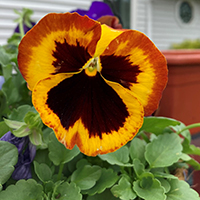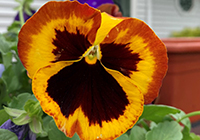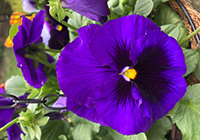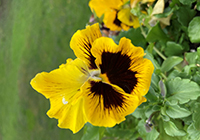What is nicer than coming face to face with those ambassadors of beautiful things to come from the garden than the Pansy (viola tricolor L.). Their brilliantly colored blooms, some presenting sharply contrasting colors, some with more subtle slides along a monochromatic scale, all with velvety soft petals are a joyous herald of the pleasure of growing flowers all summer long, a pleasure you can enjoy at Hilltop Gardens.
Pansies have been a favorite of romantic writers for centuries. In her distress at the death of her father, Shakespeare’s character Ophelia, in his play Hamlet (Act 4 Scene 5), gives pansies to others, telling them, “There is Rosemary, that’s for remembrance. Pray, love, remember. And there is pansies; that’s for thoughts.” Pansy was considered the symbol for thoughts and faithfulness, and here it is interpreted by some to mean Ophelia’s feelings toward her departed father.
In his play Midsummer Night’s Dream, Oberon and Puck (Act II Scene I) create a love potion from essence of the herb love-in-idleness (pansy), described as “a little western flower, before milk-white, now purple with love’s wound”. Putting drops of the juice on the eyes of the sleeping Demetrius will cause him to fall in love with the first person he sees when he awakens.
Pansy is also known by the names heartsease, Johnny-Jump-Up, and, in romantic verse love-in-idleness, hinting that it affects the person’s emotional state more than the physical state. Its traditional use as a symbol of thoughts is suggested in its French name pensée, which might also have reflected on its medicinal use as a panacea, a cure for all ills.
Herbalist John Gerard who promoted the ‘doctrine of signatures’, which was prominent in the medicinal treatments of the 16th and 17th centuries. Gerard praised the plant’s medicinal qualities recommending it for convulsions, fits, inflammation of the lungs and chest, scabs and itching of the whole body and for ulcers. Today, in Europe, the leaf is used as folk medicine for fevers, a gargle for sore throats and a mild laxative and is recognized as a diuretic, expectorant, mild sedative, and a blood purifier. It has also been used for asthma, heart palpitations and eczema as it is a source of rutin. It carries the warning that, due to containing saponins, it may be toxic in larger doses.
Back then, pansies only grew in a single color of purple/blue, yellow, or white. It was an English gardener named William Thomson who in 1839 created the three blotches on its petals by crossbreeding three different flowers. Now there are over five hundred species of pansies with big faces, spectacular markings, curly or straight petals, many colors, and sizes.
We also enjoy its relative, the wild violets in purple and in yellow, that grow in our yards, especially in spring. Candied violets on a salad or decorating dessert are a delightful treat.
Pansies like full or partial sun and do best in cooler temperatures, great for hanging planters through early summer. In the soil space 7 to 12 inches apart. They will grow to a height of 6 to 9 inches and spread 9 to 12 inches. They like rich, well-drained soil and afternoon shade. Fertilize and water regularly.
Deadheading spent blooms encourages new growth. The blooms will die down as the weather heats up, but the seeds fall into the pots or on the ground and may bloom again. I have even had the hearty little plants overwinter on the deck with little protection and bloom the next spring.





